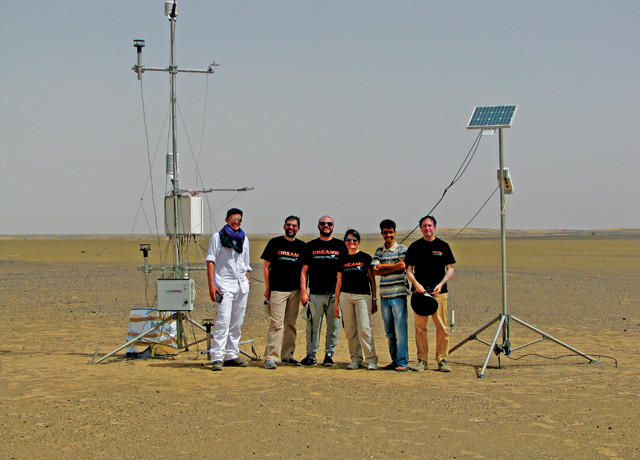
by Lucas Joel Monday, October 17, 2016

Francesca Esposito (third from right) and her research team measure dust and electric fields in the Sahara Desert. Credit: Francesca Esposito.
During the Dust Bowl of the 1930s, black blizzards of dust enveloped the Great Plains, destroying crops. When farmers heard a crackling sound over the radio, they often knew a dust storm was coming, as such storms carry an electric field that can disrupt electronic equipment. Scientists have known since the 1800s that these fields exist, but how they might affect the swirling dust around them has not been understood. In airborne dust over the Sahara Desert, scientists have now directly measured these electric fields for the first time and found that, if strong enough, the fields can lift vast amounts of dust into the air.
“The amount of dust levitated by wind alone cannot account for the levels of airborne dust measured in the field,” says Francesca Esposito, a planetary scientist at the Astronomical Observatory of Capodimonte in Naples, Italy, and lead author of the new study in Geophysical Research Letters. “You see more dust than expected by a factor of 10,” she says. So the team investigated how much the electric field and dust are interacting.
They found that as more dust becomes airborne, the electric field grows stronger.
“If you get a strongly electrified dust, that can feed back on itself and help levitate and loft more dust,” says Giles Harrison, an atmospheric physicist at the University of Reading in England who was not involved in the new study. “In other words, you can get a runaway effect of the suspension of dust as a result of electrical forces.” To generate such lift, the team found, the electric field needs to produce about 1,500 volts per meter on the ground, about 10 times the natural background level.
The process begins as small, negatively charged dust grains bounce along the surface above grains with positive charges. “If you have a negative charge above the surface, the surface will get positively charged,” says Nilton Renno, an atmospheric scientist at the University of Michigan who was also not involved in the new work. “It’s like when you run a comb through your hair, it becomes charged and, when it comes close to small pieces of paper, the pieces become attracted to the comb,” he says. “It’s the same thing, but instead of the charge with the comb, you have a charge with dust particles.”
The next question is how such electric fields and dust storms might affect Mars missions, Esposito says. She is the scientist-in-charge of the DREAMS project, which is part of the European Space Agency’s Schiaparelli mission to Mars, which was scheduled to land in October of this year. Part of the DREAMS mission is to measure electric fields in dust storms on the Red Planet: “There’s never been a probe that’s gone to Mars that’s been capable of detecting whether there’s any electricity in the atmosphere there,” Harrison notes.
Mars’ dust transportation is a mystery, Renno says, because the atmosphere is very thin — about 1 percent the density of the atmosphere at the surface of Earth. “To lift dust on Mars,” he says, “you need wind speeds much higher than have ever been measured or observed” there. This means that, perhaps, “electrification on Mars might have an effect on dust lifting” and transport, Renno says.
If Mars’ atmosphere is indeed electrified, Esposito adds, this could present an obstacle for any future manned missions to the planet, as the charged air may disrupt their communications instruments, just as it did to radios during the Dust Bowl.
© 2008-2021. All rights reserved. Any copying, redistribution or retransmission of any of the contents of this service without the expressed written permission of the American Geosciences Institute is expressly prohibited. Click here for all copyright requests.